For all the wrong reasons, Slither holds its very own special place in classic arcade gaming history. Released by Game Domain International (GDI) in 1982, it could be politely argued that the game was inspired by Atari’s seminal Centipede title released two years previously. Slither came and went very quickly, and as you’ll read below, even if Atari wanted to flex its legal muscles about it, they would never get the chance…
Slither drops the player into a garish looking desert landscape where controlling a blaster, he has to clear the area of a variety of snakes, pterodactyls and mutant gorillas (hey this is a video game after all!). The action is controlled using a trackball and fire button, and unlike Centipede, the player has free movement throughout the screen, and can fire the blaster in two directions.
Here’s a quick gameplay video which should set the scene for you:
Those sounds would drive me crazy after 2 minutes I think, especially the manic ‘Flight of the Bumble Bee’ music that appears at certain points.
GDI as a company don’t have much of a history, and the research I’ve done doesn’t reveal a great deal, other than they were an independent manufacturer of licensed video games. You might be more familiar with their only other release, Red Alert produced under licence from Irem in late 1981.

The common theme throughout their short story is that they were always struggling for liquidity. Having had moderate success with Red Alert, and securing a licence for Slither from Century II, GDI was clearly desperate to grab a share of the arcade spoils to be had in the early eighties. Someone obviously thought Slither was going to be the game that was going to take the company into the big time.

Slither was originally developed by Century Tech Corporation (in Appleton, WI), a privately held contract hardware manufacturer whose main customer was Taito America. Century Tech had their own set of issues and just as Slither development was finishing up, the company was reorganised and became known as Century II.
In fact, the hardware platform used for Slither was the same as that for the Taito America game Qix – another game previously developed by Century Tech.
So keen were GDI to raise funds to get Slither out to market, they heavily discounted their already-released game Red Alert, pricing their remaining unsold cabinet inventory at an almost unheard of price of $1,299. (This started a chain reaction with many other titles following a similar path). They went looking for investors, and persuaded an operator in Pennsylvania to inject $50,000 into the company.
But it wasn’t enough. Their owner, X-COR International, decided to put feelers out. After a short search, GDI was sold to an outfit called Destron. It seemed like a good match at the time. Destron up until then had manufactured and released mechanical coin-operated gaming devices, which had unceremoniously been shoved aside by operators and players in preference to video games. Understandably, they were keen to get a foothold on the shiny new video arcade market, and with this supposedly great new game already secured and ready for release, Destron decided to bite.
So in May of 1982, Destron purchased virtually all of the assets of GDI from X-COR. At the time of the purchase, GDI was indebted to Continental Illinois Bank for approximately $600,000 – this was quite a debt for a relatively unknown manufacturer in 1982 with only one arcade release under its belt. Incredibly, in order to fund the purchase, the very same bank loaned Destron $600,000 which was used to pay off GDI’s existing loan at Continental.
Additionally, Continental loaned Destron $695,000 to be used as working capital between June and August 1982. It is interesting to note that Continental seemed quite happy to throw money at the project against the backdrop of the explosive video game industry back then. After all, this was 1982, the very height of the Golden Age, and no-one could see it ending. Video games were mainstream, and they were everywhere. From an investment point of view, the bank clearly saw it was a dead cert. Or so they thought.
Slither slowly started rolling out during the late summer of 1982. The game promised profits and a raft of features:
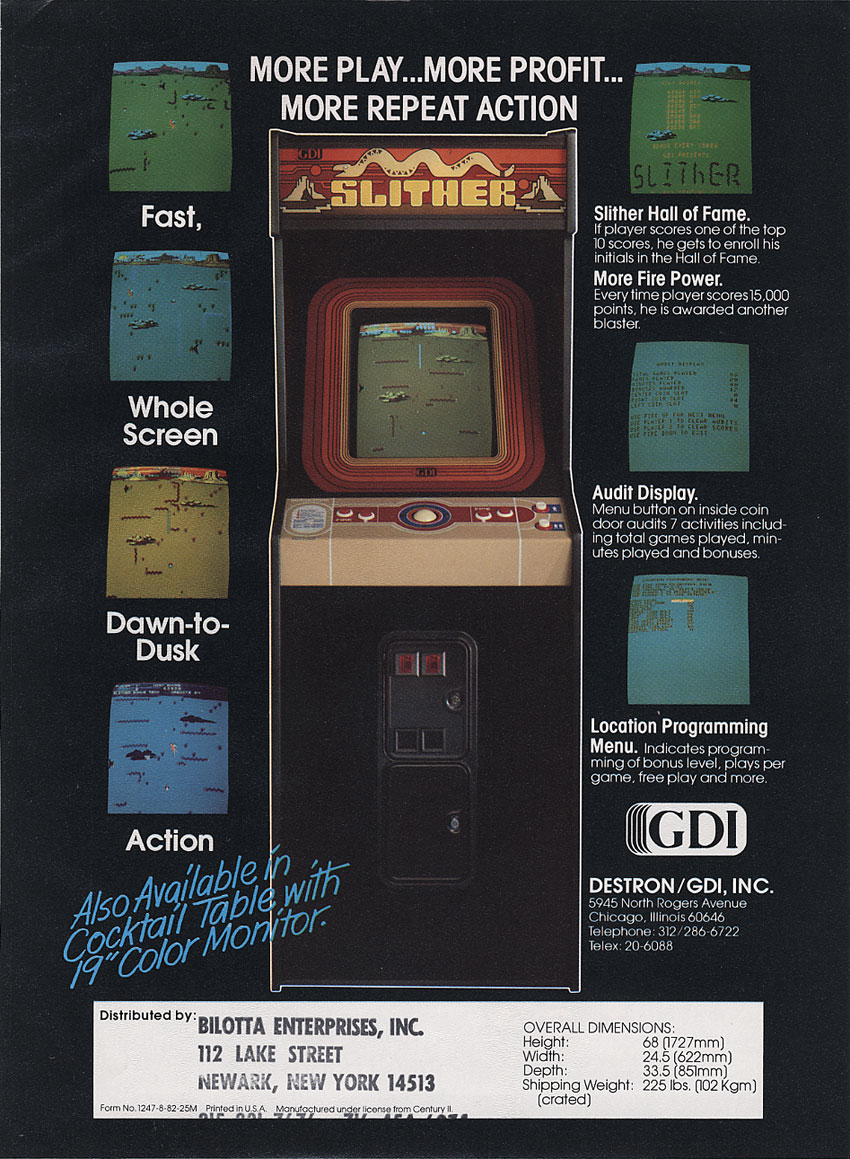
But sales were slow. Operators weren’t convinced about the game’s originality, nor its ability to hold players’ attention. It bombed spectacularly. In a market dominated by manufacturers like Atari, Williams and Taito, the game simply couldn’t get traction. The company was stuck. Destron was still servicing the huge loans it had taken on, and probably underestimated the production and distribution costs of a new arcade title. Couple that with inventory that simply wasn’t selling to an already oversaturated market, it was burning through its working capital – capital that was accruing interest.
The production line was starting to back up with unsold Slither cabinets, and so a decision was made to stop buidling new ones until the machines already made could be sold. New games couldn’t be designed until cash came in from Slither sales. This was a classic case of Catch 22.
Seeing the writing on the wall, and not convinced with the ongoing business case, Continental ceased funding Destron in September 1982. Despite managing to stay afloat for a few more months, Destron became over-extended on it’s vast loans, and on June 13, 1983, it filed for bankruptcy and started liquidation proceedings. Destron/GDI existed for just 12 short months, and managed to release a single poor-selling game – Slither.
Clearly, everyone involved had bought into the hype. They saw Slither as being a huge game. GDI were convinced, Destron were convinced, and they in turn convinced Continental Bank to cough up $1.3 million to make it happen.

Things got even messier when the unpaid suppliers to Destron/GDI realised they were unlikely to get paid. Churchill Cabinet Company was the manufacturer of the wood cabinets used to house the Slither game. Destron was a customer of Churchill both before and after the purchase of GDI. Prior to May 1982, Destron had a credit limit of $50,000 with Churchill. In order to fund its increased manufacturing capacity required to get Slither released, Destron negotiated increased credit from Churchill. They went down owing them almost $123,000, and despite their best legal efforts, Churchill never saw a dime of that money.
It was a nightmare scenario. Destron had bet everything on one game, only to crash and burn spectacularly, taking with them their investors, and the goodwill and money of their suppliers.
So Slither represents an interesting slice of classic arcade history, not so much for its game play, but for what it represents. The story behind its release is a great example of the start of the end of the Golden Age. It proved that the video arcade market did have limits, as everyone involved was to find out just a short time later when things imploded completely.
The game today holds something of a cult status. It is housed in a striking looking cabinet. Collector Bradley from Wisconsin recently acquired a Slither and shared some photos with me. What makes it particularly interesting is the fact that it was still brand new in its box! Bradley had an interesting back story to tell:
The guy I bought it from said that back in the early 80’s, he was owed money, and got paid with a few Slither machines. This one was left in the actual box with the GDI Logo on the side.
Bradley – collector from Wisconsin
You can surmise all sorts of things from that – but the fact that someone saw this particular arcade machine as something they could use to pay a debt speaks volumes of its stature in the marketplace at the time.
The pictures of the machine that Braldey acquired though are nothing short of stunning:

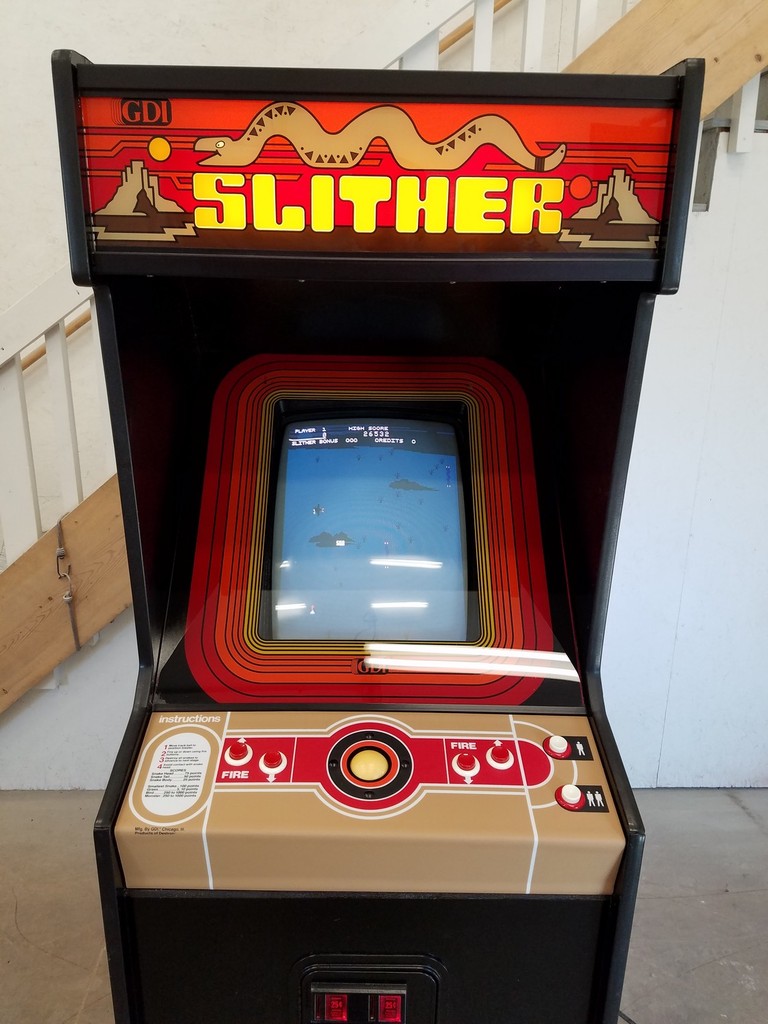
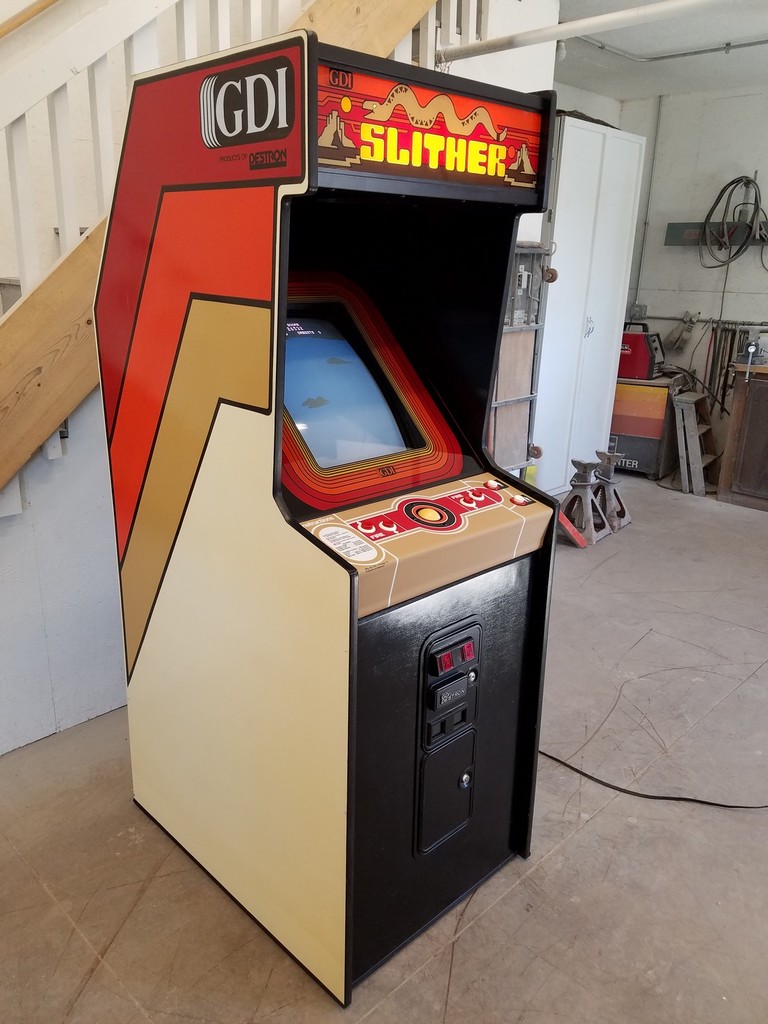
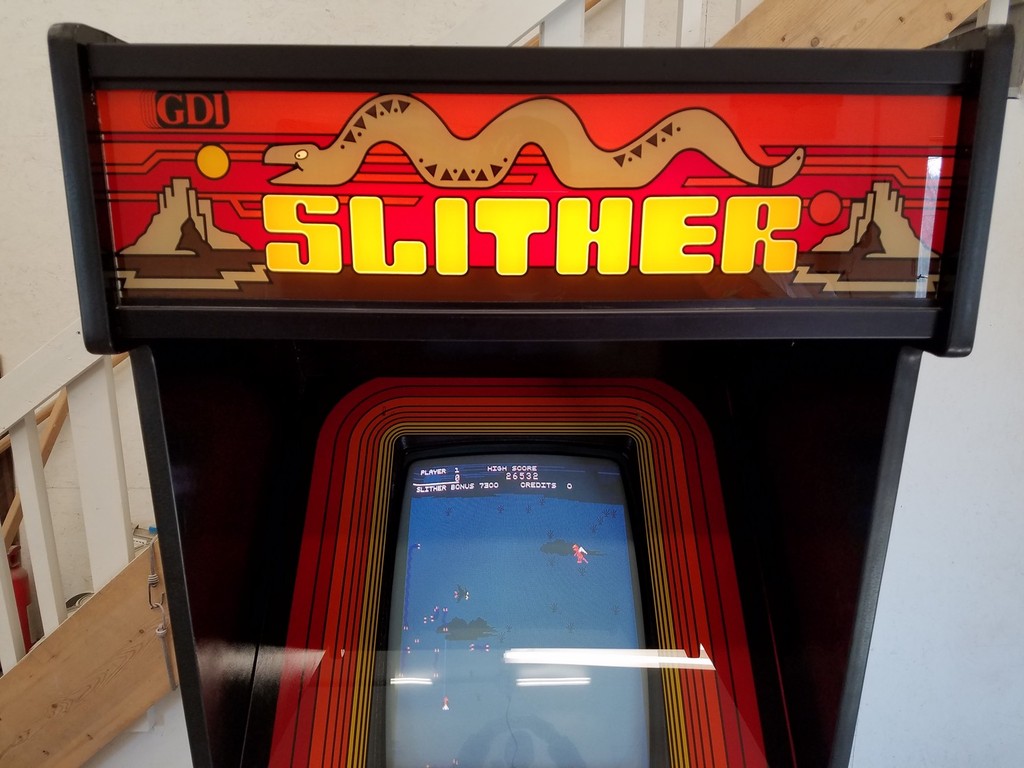

Bradley has a thing for Slither. He owns three of them. Here’s something you won’t see everyday (or indeed back in 1982!):


I think it is a glorious looking cabinet. That design on the side is fabulous. An estimate on numbers out there now? I’d say in the tens, given that only a few hundred were ever built. Most will have been destroyed or converted into something else.
In 2022, a very rare Slither cocktail table came up for sale. This game was converted to Birdie King at some point in its life, so the control panels are unhacked as they only utilise the trackball of the original game. (Thanks to Canadian collector Mike “AncientGames” on KLOV for these pictures):

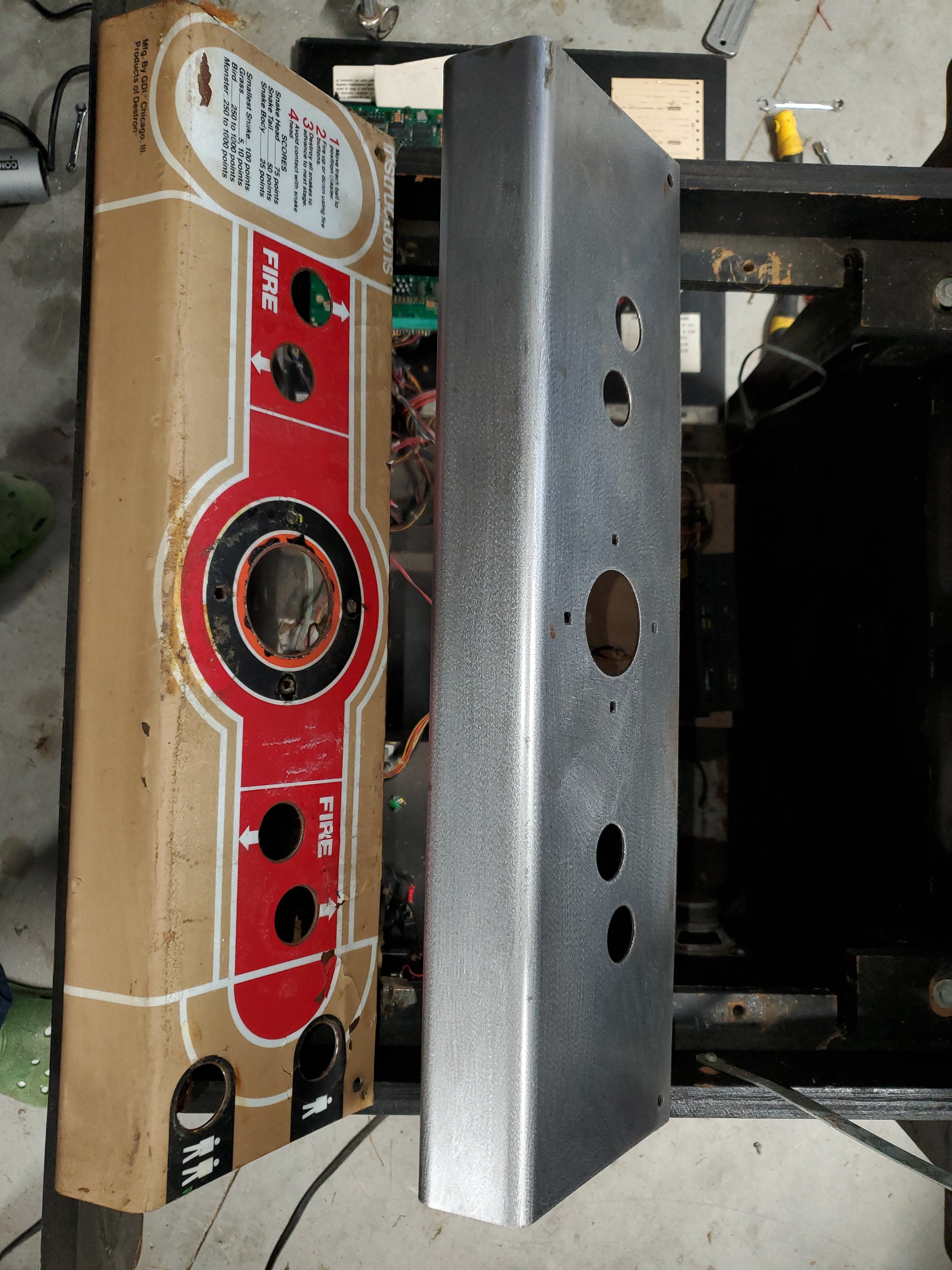

So there you have it. GDI’s Slither – quite the story. Look it up on MAME, or better still go find one and play it, if you can!
Thanks go to Bradley for sharing these great photos with us – do check out his Facebook page at Silver Coin Arcade for more pictures of cool vintage arcade cabinets.
Your visit is appreciated as always. Please help me spread the word about the blog using the social media buttons below.
Thanks
Tony
Note: The bulk of info for this article was gleaned from the archived court case notes from Churchill’s attempts to recoup some of its losses. The case is archived in several places, but online you can find the key document here. Other information was sourced from various internet arcade forum posts made by people around at the time.

Completely new one on me. Nice job, Tony.
LikeLiked by 1 person
This game was also licensed by Coleco and was the pack-in for their Roller (trackball) Controller for the Colecovision
LikeLiked by 1 person
Never heard of this one Tony, which is understandable having read the article. I really like the cabinet though, very striking, even if it does look very Atari-ish!
LikeLiked by 1 person
Do you have any source citations for any of the information you provided in your articles?
LikeLiked by 1 person
Sure. I’ve updated the article with source info.
LikeLike
Great article sir, thanks for taking the time to research and write it up.
LikeLiked by 1 person
Thanks for sharing this great write up on such an interesting piece of arcade history.
LikeLiked by 1 person
A great article again, thank you very much!!
LikeLiked by 1 person
Great Article. I’d never heard of this game, but the story itself is the classic example of counting one’s chickens before they hatched.
LikeLiked by 1 person
I snagged one in an arcade raid, got it up and running and sold it to a friend. I think he still has it. Kinda fun game, actually.
LikeLiked by 1 person
My father worked for the company that made Slither. I remember when they launched it. They expected a huge hit. They also made Biorhythm machines, those Chicken laying an egg vending machines and a few other games (crime wave, I believe was one)
They were located in Bensenville IL.
If I could find one, I would definitely buy it 🙂
LikeLiked by 1 person
Interesting stuff – thanks John!
LikeLike
Was sanding an arcade machine that someone painted grey…..turns out it’s an original Slither machine.
LikeLiked by 1 person
Tony, my father was President of Destron during its short life span. I recall the game was market tested and performed well enough that it went into production with high expectations as indicated in the comment by John Maros. It was my understanding that Continental Bank’s commitment to fund marketing and distribution costs was withdrawn after the collapse of Penn Square Bank, which ultimately wiped out Continental Bank as well. I have had a well-preserved cocktail table version of this game locked in my basement since 1987.
LikeLiked by 1 person
Thanks for the posting here Lance – very interesting to hear another version of events. Wasn’t aware of a cocktail table version either – a rare beast indeed!
LikeLike
@lance I am George’s son. I remember meeting Don several times. Super nice guy.
LikeLiked by 1 person
Hi, I used to work at Destron and was Don Desmond’s (Chairman) nephew. We did very well originally with our Biorhythm machine. Then stated thinking big and got in trouble due to bad timing in the game industry. Fun while it lasted!
LikeLiked by 1 person
I was at the 2023 Oak Creek WI hamfest on July 8 and met somebody who worked for GDI.
I mentioned the AMOA show and he replied they couldn’t afford a booth on the floor so they demoed the game in a hotel room upstairs. A prospective customer from Italy wanted to buy a bunch of Slithers but didn’t speak English so they needed a translator. The guy said it was a very surreal moment and the deal never happened.
The guy mentioned he actually had lunch with an Atari rep/lawyer at a local restaurant about Slither’s similarity to Centipede. The rep said Atari would sue them but according to the GDI guy nothing happened because the game never sold in significant numbers.
When GDI sold the rights to Coleco for the Colecovision version Coleco was looking for someone to repair returned CVs. GDI soon became a CV repair shop.
The GDI guy said the owner wasn’t big on paying Uncle Sam their payroll taxes and got into trouble for that.
Didn’t get the guy’s name but he recently sold his ST:TNG pinball for $4K. He said he hadn’t played it in many years. So if someone recently got a TNG for 4K from a 60ish guy we might be able to track him down. If nothing else I might see him next year at the same hamfest.
LikeLiked by 1 person